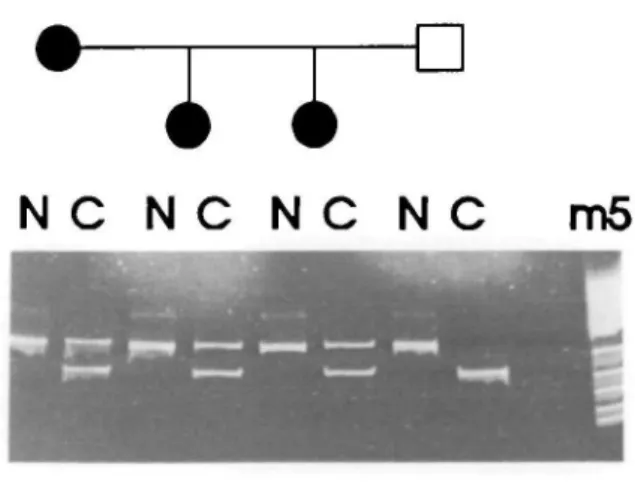©1994 Oxford University Press Human Molecular Genetics, 1994, Vol. 3, No. 7 1201
An additional family with Startle disease and a G1192A mutation at the
subunit of the inhibitory glycine receptor gene
Daniel F.Schorderef, Graziano Pescia, Andrea Bernasconi1 and Franco Regll1
Division of Medical Genetics and 1Department of Neurology, CHUV, 1011 Lausanne, Switzerland Received April 8, 1994; Revised and Accepted May 3, 1994
Recently, Shiang and colleagues have identified the gene responsible for Startle disease (1). This disease also known as hereditary hyperplexia or Kok disease is characterized by marked but transient infantile hypertonia and exaggerated startle response (2). Sequence analysis of the a\ subunit of the inhibitory glycine receptor (GLRA1) showed a mutation at the same codon 271 in four out of seven tested families (Gl 192A and Gl 192T) (1). We have analyzed this gene in a family of Swiss origin and found the Gl 192A mutation changing an ARG to a LEU codon. This report confirms that the GLRA1 gene is responsible for Startle disease and describes a simple digestion-based assay for the detection of codon 271 mutation.
The proband, a 17-year old girl of Swiss origin, was referred to our Hospital for diagnosis and treatment of numerous episodes of falling and myclonia in response to stimuli. She is the second daughter of non-consanguineous parents. Her older sister and mother both suffer abnormal startle reflex. The mutations described by Shiang etal. (1) at codon 271 involve a TaqI (and Xhol) site which allows for their rapid detection by restriction enzyme digestion. In the normal sequence, the TaqI site TCGA is present and complete digestion of PCR-amplified genomic DNA will produce two fragments of equal size. If, however, a mutation is introduced, the mutated site will not be cut and 2 bands will be seen, one from the normal and one from the mutated chromosome. In order to test for these mutations, DNA was extracted from peripheral lymphocytes and exon 6 of GLRA1 was amplified using the described primers without the GC-clamp (1). Amplicons were digested with TaqI at 65°C in the recommended buffer, fragments were separated on a 7% poly aery lamide mini-gel for 60 min. at 60 W and the gel was stained with ethidium bromide.
Figure 1 shows the TaqI digestion of the PCR products from the reported family. Affected individuals reveal 2 bands while only one is present in the unaffected father. Because destruction of the TaqI site could be due to mutation in any of the 4 bases defining the recognition site of the enzyme, amplicons from the proband were subcloned in pUC 18 and one clone showing loss of the TaqI site was sequenced on an A.L.F. automated sequencer to determine the exact mutation. The mutation found was a G to A transition at position 1192.
Thus, 50% of the families analyzed at a molecular level present a Gl 192A mutation. This may arise from a common ancestor
or from the presence of a mutational hot spot at that particular location. CpG dinucleotides are frequently involved in point mutations probably as the result of methylation-deamination. Deamination of a 5'-methylated CpG dinucleotide in the non-sense strand would create a CpA at the non-sense strand and could thus be responsible for 3 out of 4 mutations at codon 271. However, the fact that another point mutation has occurred at the same position would also suggest that Arginine at position 271 is critical for the function of the inhibitory glycine receptor gene.
ACKNOWLEDGEMENTS
We are very grateful to Sylvie Luthi and Farid Ahmad for technical assistance.
REFERENCES
1. Shiang.R., Ryan.S.C, Zhu.Y., Hahn.A.F., O'Connell.P. and WasmuthJ.J. (1993) Nature Genet. 5, 351-357.
2. Kok.O. and Bruyn.G.W. (1962) Lancet 1, 1359.
i i
N C N C N C N C
Figure 1. Agarose gel of TaqI digested and control PCR-amplified DNA stained with ethidium bromide. N: not cut; C: TaqI cut. M5 is a DNA molecular weight marker (marker V from Boehringer Mannheim GmbH, lowest band on the gel is 184 tip).
